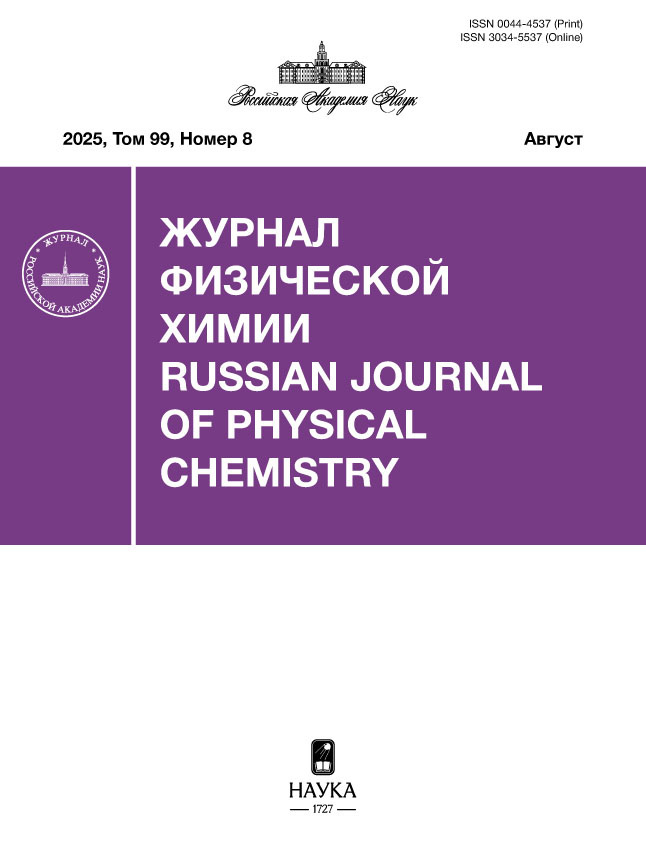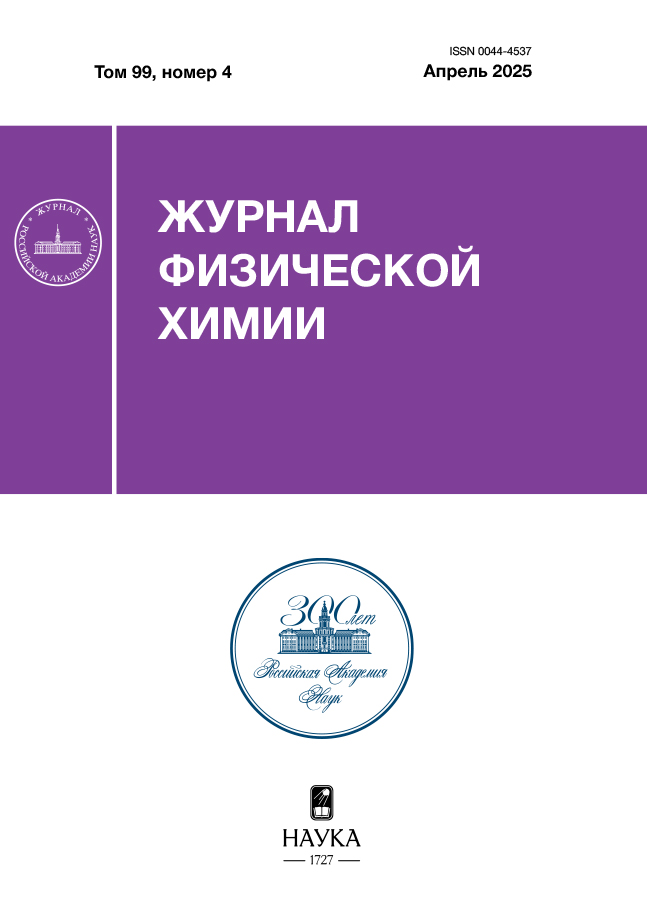Adsorption and reaction of molecules of nitrogen oxide (NO) on the surface of nickel nano-sized clusters on aluminium oxide α-Al2O3(0001)
- Authors: Magkoev T.T.1, Pukhaeva N.E.1, Men Y.2, Behjatmanesh-Ardakani R.3, Elahifard M.3, Ashkhotov О.G.4
-
Affiliations:
- North Ossetian State University named after K. L. Khetagurov
- Shanghai University of Engineering Science
- Ardakan University
- Kh. M. Berbekov Kabardino-Balkarian State University
- Issue: Vol 99, No 4 (2025)
- Pages: 611-619
- Section: PHYSICAL CHEMISTRY OF NANOCLUSTERS, SUPRAMOLECULAR STRUCTURES, AND NANOMATERIALS
- Submitted: 14.06.2025
- Accepted: 14.06.2025
- Published: 15.06.2025
- URL: https://rjdentistry.com/0044-4537/article/view/684402
- DOI: https://doi.org/10.31857/S0044453725040102
- EDN: https://elibrary.ru/FPDETK
- ID: 684402
Cite item
Abstract
Adsorption and reaction of nitrogen oxide (NO) molecules on the surface of a model metal-oxide system formed by controlled deposition of nickel clusters under ultrahigh vacuum conditions on the surface of α-Al2O3(0001) aluminum oxide thin film grown on the Mo(110) substrate is studied in-situ by experimental surface analysis methods. According to X-ray photoelectron and electron Auger spectroscopy, infrared Fourier spectroscopy, and temperature-programmed desorption data, there is a conditional Ni cluster size of 2 nm that separates the nature of the electronic state of NO molecules adsorbed on their surface and their reactivity. It is found that the peculiarity of Ni clusters with a characteristic size not exceeding 2 nm is that NO molecules are adsorbed on their surface in the form of dimers (NO)2 while for clusters of larger size adsorption occurs in the form of monomers (NO). It is concluded that this difference is the reason for the different reaction behavior of the molecules. The key difference between clusters smaller and larger than 2 nm in size is that in the former case N2O molecules are formed upon heating the system and desorbed into the gas phase while this does not occur in the latter case. The formation of N2O is due to the mutual influence of NO molecules forming the (NO)2 dimer under the action of the metal/oxide interface. The results indicate that it is possible to tune the catalytic efficiency of the metal-oxide system by varying the size of the applied metal cluster.
Full Text
About the authors
T. T. Magkoev
North Ossetian State University named after K. L. Khetagurov
Author for correspondence.
Email: t_magkoev@mail.ru
Russian Federation, Vladikavkaz, 362025
N. E. Pukhaeva
North Ossetian State University named after K. L. Khetagurov
Email: t_magkoev@mail.ru
Russian Federation, Vladikavkaz, 362025
Y. Men
Shanghai University of Engineering Science
Email: t_magkoev@mail.ru
School of Chemistry and Chemical Engineering
China, Shanghai, 201620 PRR. Behjatmanesh-Ardakani
Ardakan University
Email: t_magkoev@mail.ru
Department of Chemical Engineering, Faculty of Engineering
Iran, Islamic Republic of, Ardakan, P. O. Box 184, IRM. Elahifard
Ardakan University
Email: t_magkoev@mail.ru
Department of Chemical Engineering, Faculty of Engineering
Iran, Islamic Republic of, Ardakan, P. O. Box 184, IRО. G. Ashkhotov
Kh. M. Berbekov Kabardino-Balkarian State University
Email: t_magkoev@mail.ru
Russian Federation, Nalchik, 360004
References
- Shiotari A., Koshida H., Okuyama H. // Surf. Sci. Rep. 2021. V. 76. P. 100500. https://doi.org/10.1016/j.surfrep.2020.100500
- Kim D.H., Ringe S., Kim H. et al. // Nature Commun. 2021. V. 12. P. 1856. https://doi.org/10.1038/s41467-021-22147-7
- Rosca V., Duca M., de Groot M.T., Koper M.T.M. // Chem. Rev. 2009. V. 109, P. 2209. https://doi.org/10.1021/cr8003696
- Hu Y., Griffiths K., Norton P.R. // Surf. Sci. 2009. V. 603. P. 1740. doi: 10.1016/j.susc.2008.09.051
- Smirnov M.Y., Gorodetskii V.V., Block, J.H. // J. Mol. Catal. A: Chem. 1996, V. 107. P. 359. https://doi.org/10.1016/1381-1169(95)00175-1
- de Vooys A.C.A., Koper M.T.M., van Santen R.A., van Veen J.A.R. // J. Catal. V. 2001. V. 202. P. 387. https://doi.org/10.1006/jcat.2001.3275
- Hess C., Ozensoy E., Yi C.-W., Goodman D.W. // J. Am. Chem. Soc. V. 2006. V. 128. P. 2988. doi: 10.1021/ja057131q
- Paul D.K., Smith B.W., Marten C.D., Burchett J. // J. Mol. Catal. A: Chemical. 2001. V. 167. P. 67. https://doi.org/10.1016/S1381-1169(00)00492-1
- Fuente S.A., Fortunato L.F., Domancich N. et al. // Surf. Sci. 2012. V. 606. P. 1948. http://dx.doi.org/10.1016/j.susc.2012.08.003
- Brown W.A., King D.A. // J. Phys. Chem. B. 2000. V. 104. P. 2578. doi: 10.1021/jp9930907.
- Conrad H., Ertl G., Kuppers J., Latta E.E. // Surf. Sci. 1975. V. 50. P. 296. https://doi.org/10.1016/0039-6028(75)90026-6
- Henry C.H. // Surf. Sci. Rep. 1998. V. 31. P. 235. https://doi.org/10.1016/S0167-5729(98)00002-8
- Hirschmugl C.J. // Surf. Sci. 2002. V. 500. P. 577. https://doi.org/10.1016/S0039-6028(01)01523-0
- Chen P.J., Goodmann D.W. // Surf. Sci. 1994. V. 312. P. L767. https://doi.org/10.1016/0039-6028(94)90719-6
- Magkoev T.T., Christmann K., Moutinho A.M.C., Murata Y. // Surf. Sci. 2002. V. 515. P. 538. https://doi.org/10.1016/S0039-6028(02)01972-6
- Venables J.A. Introduction to Surface and thin Films Processes. Cambridge: Univ. Press, 2010. 372 p. ISBN: 9780511755651. https://doi.org/10.1017/CBO9780511755651
- Baumer M., Freund H.-J. // Progr. Surf. Sci. 1999. V. 61. P. 127. https://doi.org/10.1016/S0079-6816(99)00012-X
- Grigorkina G.S., Zaalishvili V.B., Burdzieva O.G. et al. // Solid State Commun. 2018. V. 276. P. 28. https://doi.org/10.1016/j.ssc.2018.04.001
- Magkoev T.T. // Vacuum. 2021. V. 189. P. 110220. https://doi.org/10.1016/j.vacuum.2021.110220
- Chen J.G., Erley W., Ibach H. // Surf. Sci. 1989. V. 224. P. 215. https://doi.org/10.1016/0039-6028(89)90911-4
- Demir S., Fellah M.F. // Surf. Sci. 2020. V. 701. P. 121689. https://doi.org/10.1016/j.susc.2020.121689
- Beniya A., Isomura N., Hirata H., Watanabe Y. // Surf. Sci. 2013. V. 613. P. 28. https://doi.org/10.1016/j.susc.2013.03.001
- Blyholder G. // J. Phys. Chem. 1964. V. 68. P. 2772. https://doi.org/10.1021/j100792a006
- Aizawa H., Tsuneyuki S. // Surf. Sci. 1998. V. 399. P. L364. https://doi.org/10.1016/S0039-6028(98)00042-9
- Wimmer E., Fu C.L., Freeman A.J. // Phys. Rev. Lett. 1985. V. 55. P. 2618. https://doi.org/10.1103/PhysRevLett.55.2618
- Jennison D.R., Verdozzi C., Schultz P.A., Sears M.P. // Phys. Rev. B. 1999. V. 59. P. R15605. https://doi.org/10.1103/PhysRevB.59.R15605
- Mattsson A.E., Jennison D.R. // Surf. Sci. 2002. V. 520. P. L611. https://doi.org/10.1016/S0039-6028(02)02209-4
- Tonner B.P., Kao C.M., Plummer E.W. et al. // Phys. Rev. Lett. 1983. V. 51. P. 1378. https://doi.org/10.1103/PhysRevLett.51.1378
- Ibach H., Lehwald S. // Surf. Sci. 1978. V. 76. P. l. https://doi.org/10.1016/0039-6028(78)90065-1
- Bertolo M., Jacobi K. // Surf. Sci. 1990. V. 226. P. 207. https://doi.org/10.1016/0039-6028(90)90486-R
- Hess C., Ozensoy E., Yi C.-W., Goodman D.W. // J. Am. Chem. Soc. 2006. V. 128. P. 2988. doi: 10.1021/ja057131q
- Duarte H.A., Salahub D.R. // J. Phys. Chem. B. 1997. V. 101. P. 7464. doi: 10.1021/Jp9706801
- Pacchioni G., Rosch N. // Surf. Sci. 1994. V. 306. P. 169. https://doi.org/10.1016/0039-6028(94)91195-9
- Debeila M.A., Coville N.J., Scurrell M.S., Hearne G.R. // Catal. Today. 2002. V. 72. P. 79. https://doi.org/10.1016/S0920-5861(01)00480-1
Supplementary files















